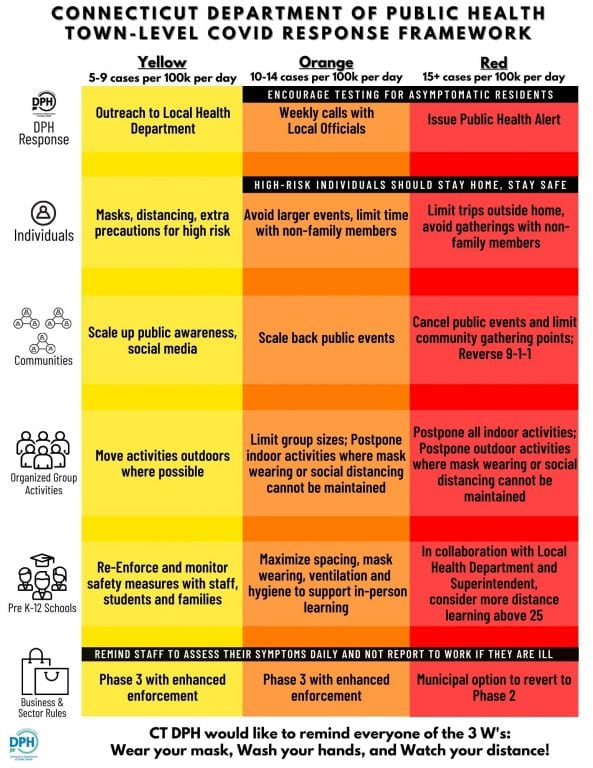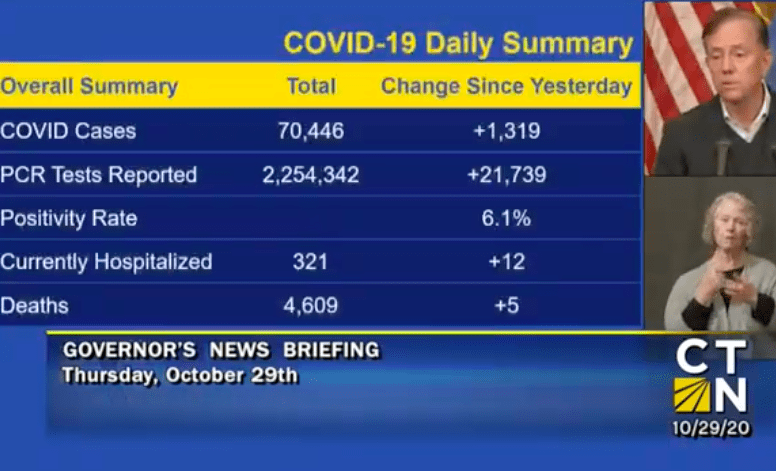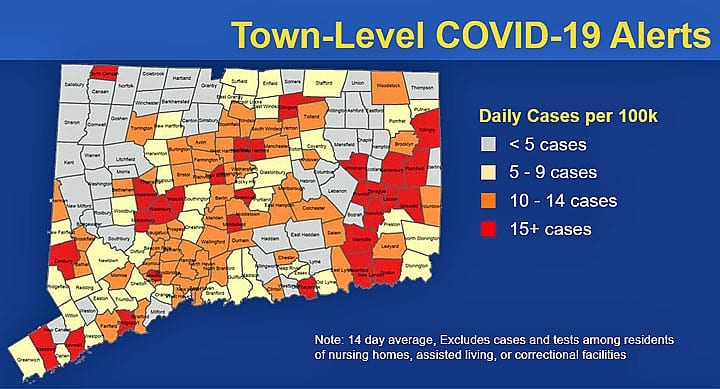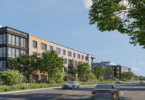West Hartford is now in the ‘orange’ range, with a rate of 12.6 cases per 100,000 over the past two weeks.

By Hugh McQuaid, CTNewsJunkie.com
West Hartford-specific information provided by Ronni Newton, We-Ha.com
Nearly a third of Connecticut’s population now lives in a city or town with “red alert” levels of COVID-19 infections, Gov. Ned Lamont announced Thursday during a press briefing that saw the state’s new infection rate at an alarming 6.1%.
“I look hard to find a silver lining and I can’t find it in these numbers except perhaps the fact that we’ve done a lot of testing,” Lamont said at the outset of his briefing. “That’s the highest rate we’ve had since June 1. Couple that with hospitalizations continuing to creep up and fatalities, there’s no good news in those numbers.”
Since Wednesday, another 12 COVID-19 patients were hospitalized, bringing the state total to 321 and another five residents died as a result of the virus. Thursday’s spike in new cases helped bump the seven-day rolling average to 3.1%.

Meanwhile, the number of towns in the “red alert” range of having more than 15 positive cases per 100,000 residents jumped sharply from 19 to 30. Lamont said those 30 towns represent about 32% of the state’s total population.
The governor said he planned to modify an existing order which allows town officials in communities in the red zone to reinstate stricter public health guidelines, capping the number of customers that can be indoors at businesses like restaurants.
The new order will allow towns in the orange range – defined as 10-14 positive cases per 100,000 residents – the same option. There are now 53 communities in the orange range, meaning roughly half the state’s towns and cities have the option to roll back to Phase 2 of the state’s reopening guidelines.
The governor recommended that any town with the option to impose stricter rules do so.
“My strong recommendation is roll back and send a message. This fire is accelerating. I think most or some of them will do it. We’ll see. I’ve heard two of our biggest cities have already stepped forward to do this,” he said.
There were seven new cases in West Hartford according to the data released Thursday, and while that is fewer than the number of cases reported over the past several days, the town has 67 cases over the past week. There were 44 cases in the previous week, and the average number of new cases per 100,000 of population over the past two weeks is now 12.6, pushing the town into the orange range.
The positivity rate over that same two-week period is 2.6%.
Aimee Krauss, director of the West Hartford-Bloomfield Health District, said earlier this week that “social gatherings and positive cases within a household” are some of the reasons for the spread in town, and increased testing is also resulting in more positive cases being identified.
“The Health District has been working with our testing locations on reminding residents to quarantine until they receive test results. Even if a person is asymptomatic they should not be attending social gatherings and parties until they get results,” Krauss said.
Spread in West Hartford does not appear to be in the public schools. As of noon Thursday, the West Hartford Public Schools COVID dashboard indicated just seven active cases among students and staff.
There were no new cases reported on the dashboard on Thursday, and just one on Wednesday involving an individual at Hall High School who was already quarantining.
Other communities near West Hartford are also in the orange range, including Avon, Farmington, and Bloomfield. Hartford remains in the “red alert” zone.
Bridgeport, one of the communities in the “red alert” zone, announced it was rolling back to Phase 2 before Lamont’s press conference ended. It’s the second town to do so.
Windham also chose to roll back to Phase 2. The move caps businesses 50% of their capacity, down from 75%, and limits gatherings to 25 people. It also discontinues the limited opening of indoor performance art centers.
Windham Town Manager Jim Rivers joined the governor remotely for the briefing. Rivers said most of his community was receptive to rolling back the restrictions once local officials communicated their reasoning.
“I think in Windham, we’re strong, we’re tough here. Even businesses that are staring at a freight train here going into winter with no outdoor seating. They’re hurting but they understand we’re trying to keep them open,” he said. “If we don’t do something now we’re going to pay the price later and maybe have to shut them down entirely.”
The governor, who typically tries to deliver bad news with a spin of optimism, seemed to be having a hard time of it Thursday. He referred to the numbers as “a gut punch.”
“I usually can say ‘don’t worry, it’s just a one day number’ … Let’s face it: we’ve gone from 1 to 2 to 3. This 6.1, it may be a harbinger of things to come. It’s going to get worse before it gets better but we’re going to weather it together,” he said.
Within hours of the briefing, New Haven, Norwalk, and Stamford moved forward with rolling back to Phase 2 precautions with more municipalities expected to follow.
Republished with permission from CTNewsJunkie.com, all rights reserved.
Like what you see here? Click here to subscribe to We-Ha’s newsletter so you’ll always be in the know about what’s happening in West Hartford! Click the blue button below to become a supporter of We-Ha.com and our efforts to continue producing quality journalism.









[…] Town of West Hartford is one of 53 communities now in the “orange” range according to da…, meaning the community has experienced an average daily positive case rate of between 10 and 14 […]
[…] Data released by the state Thursday classified West Hartford in the “orange” range, one … in the state that has an average daily number of new positive cases of between 10 and 14 per 100,000 of population over the past two weeks. West Hartford’s case rate per 100,000 was 12.6 as of Thursday, up from 9.2 the previous week. […]